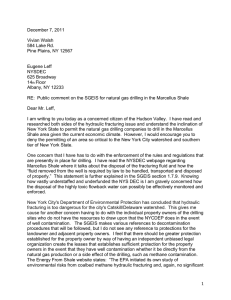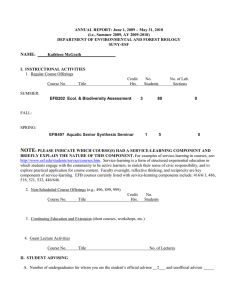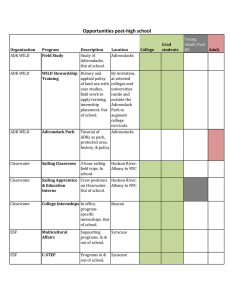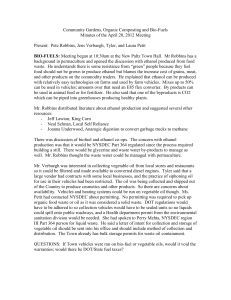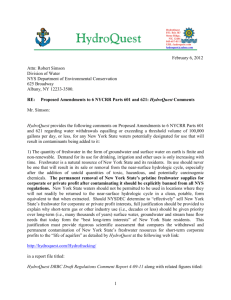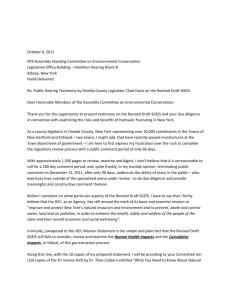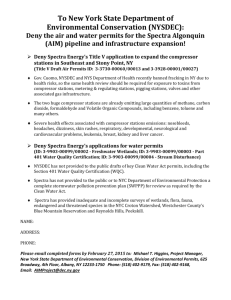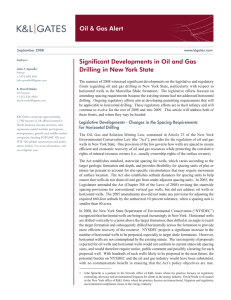Document 13847761
advertisement
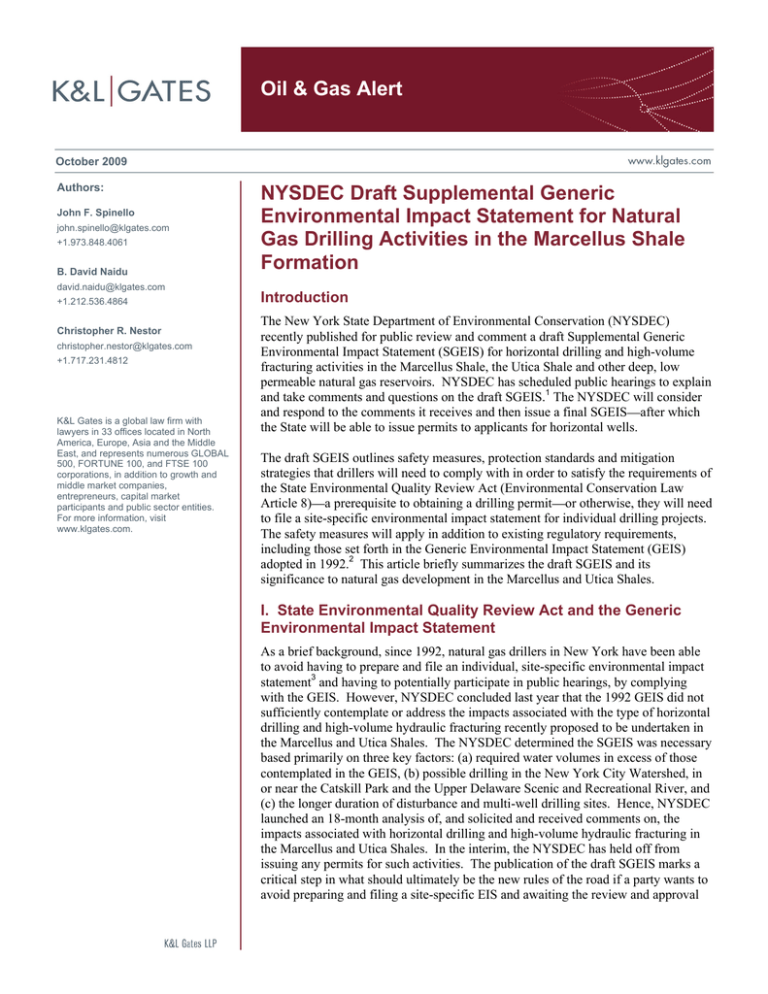
Oil & Gas Alert October 2009 Authors: John F. Spinello john.spinello@klgates.com +1.973.848.4061 B. David Naidu david.naidu@klgates.com +1.212.536.4864 Christopher R. Nestor christopher.nestor@klgates.com +1.717.231.4812 K&L Gates is a global law firm with lawyers in 33 offices located in North America, Europe, Asia and the Middle East, and represents numerous GLOBAL 500, FORTUNE 100, and FTSE 100 corporations, in addition to growth and middle market companies, entrepreneurs, capital market participants and public sector entities. For more information, visit www.klgates.com. NYSDEC Draft Supplemental Generic Environmental Impact Statement for Natural Gas Drilling Activities in the Marcellus Shale Formation Introduction The New York State Department of Environmental Conservation (NYSDEC) recently published for public review and comment a draft Supplemental Generic Environmental Impact Statement (SGEIS) for horizontal drilling and high-volume fracturing activities in the Marcellus Shale, the Utica Shale and other deep, low permeable natural gas reservoirs. NYSDEC has scheduled public hearings to explain and take comments and questions on the draft SGEIS.1 The NYSDEC will consider and respond to the comments it receives and then issue a final SGEIS after which the State will be able to issue permits to applicants for horizontal wells. The draft SGEIS outlines safety measures, protection standards and mitigation strategies that drillers will need to comply with in order to satisfy the requirements of the State Environmental Quality Review Act (Environmental Conservation Law Article 8) a prerequisite to obtaining a drilling permit or otherwise, they will need to file a site-specific environmental impact statement for individual drilling projects. The safety measures will apply in addition to existing regulatory requirements, including those set forth in the Generic Environmental Impact Statement (GEIS) adopted in 1992.2 This article briefly summarizes the draft SGEIS and its significance to natural gas development in the Marcellus and Utica Shales. I. State Environmental Quality Review Act and the Generic Environmental Impact Statement As a brief background, since 1992, natural gas drillers in New York have been able to avoid having to prepare and file an individual, site-specific environmental impact statement3 and having to potentially participate in public hearings, by complying with the GEIS. However, NYSDEC concluded last year that the 1992 GEIS did not sufficiently contemplate or address the impacts associated with the type of horizontal drilling and high-volume hydraulic fracturing recently proposed to be undertaken in the Marcellus and Utica Shales. The NYSDEC determined the SGEIS was necessary based primarily on three key factors: (a) required water volumes in excess of those contemplated in the GEIS, (b) possible drilling in the New York City Watershed, in or near the Catskill Park and the Upper Delaware Scenic and Recreational River, and (c) the longer duration of disturbance and multi-well drilling sites. Hence, NYSDEC launched an 18-month analysis of, and solicited and received comments on, the impacts associated with horizontal drilling and high-volume hydraulic fracturing in the Marcellus and Utica Shales. In the interim, the NYSDEC has held off from issuing any permits for such activities. The publication of the draft SGEIS marks a critical step in what should ultimately be the new rules of the road if a party wants to avoid preparing and filing a site-specific EIS and awaiting the review and approval Oil & Gas Alert of such site-specific submittals. Moreover, the NYSDEC takes the position that once the SGEIS is finalized, it will be able to include in drilling permits the mitigation measures described therein without the need for further regulatory action, such as the adoption of conforming regulations. o Groundwater Impacts Associated with Drilling and Construction o Hydraulic Fracturing Procedures o Waste Transportation and Disposal o Clean Water Act (SPDES) Discharges II. The Draft Supplemental Generic Environmental Impact Statement o Protecting the Quality of NYC s Drinking Water Supply The Draft SGEIS describes in detail the potential adverse effects of natural gas drilling activities on water and other natural resources. At the same time, it outlines the substantial economic and other public benefits associated with natural gas development in the Marcellus Shale and other similar formations, noting that New York is the fourth largest natural gas consuming state in the nation, using 1,200 billion cubic feet of natural gas per year, about five percent of the nation s demand. The draft SGEIS notes the Marcellus Shale is the largest known shale deposit in the world, and recoverable reserves by some estimates could be as high as 489 trillion cubic feet. It further observes that in Pennsylvania, where Marcellus Shale development is underway, Penn State found the Marcellus gas industry has already generated $2.3 billion in total value, added more than 29,000 jobs and $240 million in state and local tax revenue. It is estimated that in 2009, economic output in Pennsylvania will top $3.8 billion, tax revenue will exceed $400 million and total job creation will exceed 48,000. For these and other reasons, New York State s own draft Energy Master Plan encourages the development of the Marcellus Shale natural gas formation, with environmental safeguards that protect water supplies and natural resources. o Buffers and Setbacks from Water Resources The draft SGEIS concludes with a detailed description of the regulations that are currently in place and the additional mitigation measures NYSDEC proposes to adopt in the SGEIS and apply through conditions in well drilling permits to protect water resources and address other potential impacts. The new mitigation requirements relate to the following types of potential impacts: Protecting Water Resources o Water Withdrawals o Stormwater Management o Surface Spills and Releases at the Well Pads Protecting Floodplains and Wetlands Protecting Air Quality Mitigating Greenhouse Gas Emissions Mitigating Impacts of Centralized Flowback Water Impoundments Mitigating Naturally Occurring Radioactive Materials (NORM) Impacts Protecting Visual Resources Mitigating Noise Impacts Mitigating Road Use Impacts Mitigating Community Character Impacts Mitigating Cumulative Impacts Water Resource Protection Water Withdrawals Certain water withdrawals are currently regulated by either the Susquehanna River Basin Commission (SRBC) or the Delaware River Basin Commission (DRBC) depending upon the purpose and amount of water to be withdrawn and where the withdrawal occurs. The NYSDEC plans to regulate surface and groundwater withdrawals for all high-volume hydraulic fracturing activities, separate from and in addition to the approvals required and standards imposed by the SRBC and the DRBC. According to the NYSDEC, currently neither the SRBC nor the DRBC adequately regulate surface water withdrawals to protect against reduced stream flows that threaten fish and wildlife resources. Accordingly, to assure October 2009 2 Oil & Gas Alert adequate surface water flow, the SGEIS proposes that water withdrawals must provide for a passby flow in the stream in accordance with the Natural Flow Regime Method, which requires that withdrawals be suspended when stream flows are less than 30% of the Average Daily Flow (ADF) or Average Monthly Flows. This may require the collection of stream flow data over several seasons or the use of very conservative assumptions. Note that the proposed 30% ADF passby flow requirement would curtail withdrawals on most streams during much of the summer and fall season. Groundwater withdrawals from points located proximate to surface water bodies would also be regulated to ensure any effects on the surface water body are acceptable. Stormwater NYSDEC has determined that natural gas well development using high-volume hydraulic fracturing is eligible for inclusion in New York State s Multi-Sector General Permit for Stormwater Discharges Associated with Industrial Activity (GP-0-06-002), which currently establishes stormwater management requirements to minimize water quality effects when precipitation comes into contact with industrial activity. Under the draft SGEIS, the NYSDEC proposes to require applicants for well drilling permits to prepare and implement Stormwater Pollution Prevention Plans (SPPPs) that address the impacts of stormwater runoff associated with both construction activities and the operation of well sites. The SPPPs must include structural and non-structural Best Management Practices (BMPs)iv for the site, as well as monitoring activities, including quarterly visual monitoring, dry weather flow inspections, and annual benchmark monitoring and analysis. Surface Spills and Releases at the Well Pad To prevent and mitigate the effects of surface spills, the draft SGEIS relies in part on the existing spill prevention measures under the NYSDEC s current Petroleum Bulk Storage (PBS) Program, plus the SPPPs described above, but would impose certain additional requirements. For example, the draft SGEIS proposes that multi-well pads for high-volume hydraulic fracturing include additional secondary containment for drilling rig fuel tanks above 10,000 gallons and all tanks within 500 feet of a water feature. These tanks are currently generally considered to be nonstationary and therefore exempt from the current PBS regulations. Similar requirements for secondary containment would apply to the storage of hydraulic fracturing additives. The draft SGEIS proposes additional requirements for on-site reserve pits (which may contain drill cuttings, drilling fluid, formation water and flowback water), including volume limits of 250,000 gallons, liner specifications and fluid removal schedules. More stringent requirements would be imposed for on-site reserve pits located in primary or principal aquifer areas or unfiltered water supply areas. Given the potential volumes of flowback water, if an operator wants to have flowback water stored on-site, then it must be in steel tanks located at the well-pad and removed from the site within 45 days after completing drilling and stimulation activities at the last well on the pad. If the well-pad is located in primary or principal aquifer areas or unfiltered water supply areas, then the period of storage is limited to 7 days after completing drilling and stimulation activities at the last well on the pad. An operator may also use centralized impoundment storage to serve multiple well sites. The Environmental Assessment Form that each applicant must submit to the NYSDEC with its well drilling permit application must include detailed information about each of the above referenced potential sources of spills. Groundwater Impacts To protect private water wells, the draft SGEIS proposes supplementary permit conditions that would require each applicant to sample and test October 2009 3 Oil & Gas Alert residential water wells, subject to the owner s permission, within 1,000 feet of the well pad or in some cases within 2,000 feet. Testing for a specified range of potential contaminants would be required both prior to drilling, to establish a baseline, and ordinarily at intervals of three months, six months and one year. Additional testing would be required based upon the receipt of complaints from well owners. In addition to the current requirements for wellbore construction, including casing and cementing practices, the draft SGEIS proposes the use of a pre-frac form to certify wellbore integrity. Additional construction specifications would apply to wells located in primary or principal aquifer areas or unfiltered water supply areas. The draft SGEIS also proposes certain notification requirements prior to cementing surface casting so that a NYSDEC inspector may be present to observe. Hydraulic Fracturing Procedure If the proposed high-volume hydraulic fracturing is to be conducted where the top of the target fracture zone at any point along the entire proposed length of the wellbore is shallower than 2,000 feet, then there must be a site-specific SEQRA review. If any proposed high-volume hydraulic fracturing is to be conducted where the top of the target fracture zone at any point along the entire proposed length of the wellbore is less than 1,000 feet below the base of a known fresh water supply, then there must be a site-specific SEQRA review. Waste Transportation and Disposal The draft SGEIS proposes the use of a waste tracking system for flowback water and production brine, similar to the system currently used to track the transportation and disposal of medical waste. A tracking form will be maintained by all generators and transporters of flowback water and produced brine, as well as those who receive the material for treatment or disposal. Flowback water may not be spread on roads, and production brine may only be spread on roads under the terms of an approved Beneficial Use Determination (BUD) issued by the NYSDEC. A request for a BUD must include analytical results of tests performed by a New York State Department of Health approved laboratory on a representative sample showing acceptable concentration levels of specified pollutants. SPDES Regulated Discharges The draft SGEIS notes that flowback water and production brine are generally considered industrial wastewater and, as such, unless the recycling or reuse of the wastewater is specifically approved by NYSDEC, the treatment and disposal of these materials are subject to the permitting requirements established under the State Pollution Discharge Elimination System (SPDES) program. The SPDES program imposes requirements on both the generator of the flowback water and production brine or wastewater the well operator and the POTW or other entity receiving the wastewater for treatment and discharge. The draft SGEIS provides that NYSDEC will not permit a POTW to accept flowback water or production brine unless the Publicly Owned Treatment Works has an approved pretreatment program, and the flowback water and production brine have been fully analyzed (headworks analysis) so NYSDEC can determine that the POTW is capable of properly treating this type of wastewater. The headworks analysis will determine whether the flowback water and production brine proposed for treatment and disposal includes any substances that may inhibit or impair the effectiveness of the POTW treatment system, pass through without treatment, or otherwise cause the POTW to exceed an effluent limit or sludge quality criteria. NYSDEC plans to modify the SPDES permits for any POTWs that accept or plan to accept flowback water or production brine. October 2009 4 Oil & Gas Alert The draft SGEIS also states that, consistent with the 1992 GEIS, brine disposal wells require a site-specific SEQRA review. Protecting the Quality of NYC s Drinking Water Supply The draft SGEIS notes the importance of ensuring that well drilling does not damage or impair the subsurface water supply infrastructure (tunnels) conveying water from reservoirs in the Catskill Region to NYC. Under existing protocols, the NYSDEC provides notice to the NYC Department of Environmental Protection (NYCDEP) of all applications for well drilling permits in the counties of Delaware, Dutchess, Greene, Orange, Putnam, Rockland, Schoharie, Ulster and Westchester, and the NYCDEP determines whether the proposed well location is within 1,000 feet of a tunnel corridor. Any proposed well determined by the NYCDEP to be within 1,000 feet of a tunnel corridor cannot be approved by NYSDEC under the GEIS or the SGEIS and is subject to a site-specific SEQRA review. The NYSDEC will apply this protocol to all permit applications for proposed horizontal drilling and highvolume hydraulic fracturing activities. In addition, the draft SGEIS concludes that NYC s water supply is protected by the extensive existing regime in place to regulate activities within the NYC Watershed. The draft SGEIS proposes additional measures to protect the NYC water supply including: (1) a prohibition on centralized flowback water impoundments within the boundaries of the NYC Watershed; (2) requirements in unfiltered water supply areas to remove fluids from on-site reserve pits or tanks within seven days of completing drilling and stimulation operations at the last well on the pad or immediately if operations are suspended or left unattended; and (3) site-specific SEQRA review for any proposed well pad within 300 feet of a reservoir, reservoir stem or controlled lake, or within 150 feet of a watercourse. Protecting Floodplains The draft SGEIS proposes to protect floodplains and wetlands by ensuring that any well pad located within a floodplain uses a closed-loop tank system, instead of a reserve pit for managing fluids and cuttings. Centralized flowback impoundments and above-ground piping and conveyances will not be approved in a floodplain. Protecting Wetlands To protect wetlands, the draft SGEIS would prohibit the siting of drilling rig fuel tanks within 500 feet of a wetland, to the extent practical; require secondary containment for any drilling rig fuel tank placed within 500 feet of a wetland, regardless of size; and require a separate SEQRA review for any fluid disposal plan that includes a Centralized Flowback Water Impoundment within 500 feet of a regulated wetland. Protecting Air Quality Public exposure to Hazardous Air Pollutants (HAPs) contained in fracture additives and emitted by Centralized Flowback Water Impoundments is the NYSDEC s primary air quality concern that is not addressed by the prior GEIS or current regulations. Thus, the draft SGEIS proposes that the EAF included in all permit applications identify all proposed fracturing additives and identify the control measures to be used to prevent public exposure to HAPs contained in the additives in excess of thresholds established by NYSDEC in guidance documents. In addition, the draft SGEIS requires the use of Ultra Low Sulfur Fuel (15ppm) in all diesel equipment. Mitigating Greenhouse Gas Emissions The NYSDEC has determined that emissions of methane (CH4) from production well facilities presents the most significant impact of all Marcellus gas development activities because of October 2009 5 Oil & Gas Alert the very high CO2 equivalent factor or global warming potential of methane. Accordingly, the draft SGEIS proposes to require production well operators to implement the USEPA s Natural Gas STAR Best Management Practices. Well operators will be required to prepare and submit to NYSDEC a greenhouse gas mitigation plan incorporating these BMPs. Mitigating Impacts from Centralized Water Impoundments Operators can also use Centralized Flowback Water Impoundments as a means of containing flowback water from multiple sites, and they can be used to store such waters for longer periods than any well pad reserve pit. According to NYSDEC, given the limited information available about the characteristics of flowback water, conservative measures are necessary to protect water resources. Accordingly, under the draft SGEIS, NYSDEC will not approve a Centralized Flowback Water Impoundment in a 100-year floodplain, or within the boundaries of a primary or principle aquifer area or an unfiltered water supply. In addition, a sitespecific SEQRA review will be required for a Centralized Flowback Water Impoundment located within 1,000 feet of a reservoir, within 500 feet of a perennial or intermittent stream, wetland, storm drain, lake or pond, or within 300 feet of a private or public water supply well. In addition, the draft SGEIS proposes that all Centralized Flowback Water Impoundments be constructed in accordance with the NYSDEC s Part 360 requirements for landfills, including minimum liner requirements. The rigorous requirements proposed for these impoundments are also intended to encourage the use of tanks, instead of impoundments. Mitigating Naturally Occurring Radioactive Materials (NORM) Impacts According to the draft SGEIS, the transfer, receipt or possession of radioactive material in excess of specified concentrations or quantities is unlawful, except in accordance with the terms of a license issued by the NYSDEC. Thus, any radioactive material exceeding the specified thresholds, including production brine that is managed at a well site would be subject to regulation under this existing regulatory framework (NYSDEC Regulations Part 380). According to the NYSDEC, the presence of NORM varies significantly from place to place, thus sampling and analysis of wells at various locations will be conducted to determine variability and to determine what additional mitigation needs may be necessary. Further, the draft SPGEIS states that any discharge of effluents into the environment will need to be tested for NORM concentrations prior to the discharge. Protecting Visual Resources The draft SGEIS would require a well permit applicant to prepare and submit visual impacts mitigation plan prepared in accordance with NYSDEC s policy guidance document, Assessing and Mitigating Visual Impacts, DEP-00-02. Mitigating Noise Impacts The draft SGEIS would require a well permit applicant to prepare and submit a noise impacts mitigation plan prepared in accordance with NYSDEC s policy guidance document, Assessing and Mitigating Noise Impacts, DEP00-01. In addition, unless required otherwise by a private lease agreement, the access road must be located as far as practical from occupied structures, places of assembly and unleased property. Mitigating Road Use Impacts The draft SGEIS notes that road use is governed principally by local and state traffic laws. In addition, the draft SGEIS proposes to require that the well operator provide the NYSDEC, for informational purposes only, any road use agreement between the operator and the municipality, and, if there is no road use agreement, a copy of the operator s trucking October 2009 6 Oil & Gas Alert plan, together with documentation of its efforts to reach a road use agreement with the municipality. with reference to local land use and planning documents. III. Conclusion Mitigating Community Character Impacts As noted above, the draft SGEIS provides for additional requirements in a wide range of issues and potential activities. These requirements that NYSDEC has proposed are the most stringent requirements on horizontal drilling and high-volume fracturing activities of any state. However, some politicians have criticized the efforts as halfmeasures and have called for a ban on all drilling activity in the New York City Watershed. Thus, to the degree the regulated community wishes to influence the ultimate scope of the proposal, it is necessary to take advantage of the opportunity to comment on the draft SGEIS the comment period closes on November 30, 2009. The NYSDEC is offering three ways in which to submit comments: (a) through an on line submission system (http://www.dec.ny.gov/cfmx/extapps/SGEISComm ents/), (b) by email (dmnsgeis@gw.dec.state.ny.us), or (c) submission of written materials. Companies who believe that they will be impacted by these changes should avail themselves of one of these options in order to highlight the practical, real world impacts of these proposals, and to offer suggestions regarding preferable approaches to addressing any legitimate environmental or other impact concerns. The draft SGEIS identifies road use as the largest and most obvious potential impact to the character of a community. While acknowledging that municipalities possess the authority to regulate their roads, the NYSDEC encourages operators and municipalities to enter into road use agreements and adopt mitigation measures such as the selection of routes that maximize efficiency and public safety, avoidance of peak traffic hours, coordination with local emergency management agencies, provision of adequate off-road parking and delivery areas, and use of rail or temporary pipelines when appropriate. Mitigating Cumulative Impacts The draft SGEIS observes that cumulative impacts are best mitigated by the use of visual and noise impact mitigation plans, road use agreements, and the careful siting of well pads Anchorage Austin Beijing Berlin Boston Charlotte Chicago Dallas Dubai Fort Worth Frankfurt Harrisburg Hong Kong London Los Angeles Miami Newark New York Orange County Palo Alto Paris Pittsburgh Portland Raleigh Research Triangle Park San Diego San Francisco Seattle Shanghai Singapore Spokane/Coeur d Alene Taipei Washington, D.C. K&L Gates is a global law firm with lawyers in 33 offices located in North America, Europe, Asia and the Middle East, and represents numerous GLOBAL 500, FORTUNE 100, and FTSE 100 corporations, in addition to growth and middle market companies, entrepreneurs, capital market participants and public sector entities. For more information, visit www.klgates.com. K&L Gates comprises multiple affiliated partnerships: a limited liability partnership with the full name K&L Gates LLP qualified in Delaware and maintaining offices throughout the United States, in Berlin and Frankfurt, Germany, in Beijing (K&L Gates LLP Beijing Representative Office), in Dubai, U.A.E., in Shanghai (K&L Gates LLP Shanghai Representative Office), and in Singapore; a limited liability partnership (also named K&L Gates LLP) incorporated in England and maintaining offices in London and Paris; a Taiwan general partnership (K&L Gates) maintaining an office in Taipei; and a Hong Kong general partnership (K&L Gates, Solicitors) maintaining an office in Hong Kong. K&L Gates maintains appropriate registrations in the jurisdictions in which its offices are located. A list of the partners in each entity is available for inspection at any K&L Gates office. This publication is for informational purposes and does not contain or convey legal advice. The information herein should not be used or relied upon in regard to any particular facts or circumstances without first consulting a lawyer. ©2009 K&L Gates LLP. All Rights Reserved. 2 1 th Hearings are scheduled for Oct 28 in Sullivan County, th th November 10 in New York City, on November 12 in th Chenango County, and on Novemeber 18 in Corning. The GEIS refers to a common set of impacts associated with oil and gas drilling activities and the common mitigation measures for such activities. 3 Typically, a permit applicant submits an Environmental Assessment Form (EAF), outlining the anticipated environmental impacts of the project. NYSDEC reviews the October 2009 7 Oil & Gas Alert EAF to determine whether the project will or will not have a significant impact. If it is determined that it will not, then the NYSDEC will issue a Negative Declaration, which concludes the SEQRA process and allows the NYSDEC to consider a permit application for the activity. If the NYSDEC determines that the project will have a significant environmental impact, the permit applicant must prepare and submit an Environmental Impact Statement (EIS), and this document is subject to public notice and comment. An EIS is a detailed site-specific document that discusses the proposed activity, significant beneficial and adverse impacts of the proposed activity, the mitigation measures that are proposed to minimize the adverse impacts, and the alternatives considered that would further minimize or avoid adverse impacts. Once a draft EIS is completed, it is submitted to the NYSDEC. If the NYSDEC determines that it is adequate and complete, then this draft EIS is published for public notice and comment. After receiving comments, the NYSDEC may decide to hold a hearing on the draft EIS or alternatively, require the applicant to address the substantive issues raised during the public comment period. Once the final EIS is submitted to the NYSDEC, it will either make a positive or negative determination on the activity (or in some circumstances ask for additional information). Given the costs and time associated with completing the EIS process, most applicants seek to shortcircuit the process by obtaining a Negative Declaration whenever possible. iv Structural BMPs include dikes, swales, diversions, drains, traps, silt fences and vegetative buffers; non-structural BMPs include sheltering materials and activities to prevent exposure to precipitation, spill prevention and response, facility inspections and employee training. October 2009 8
